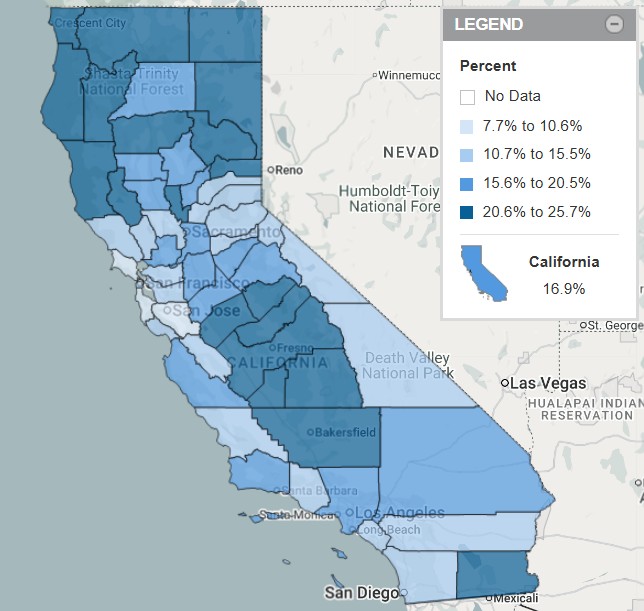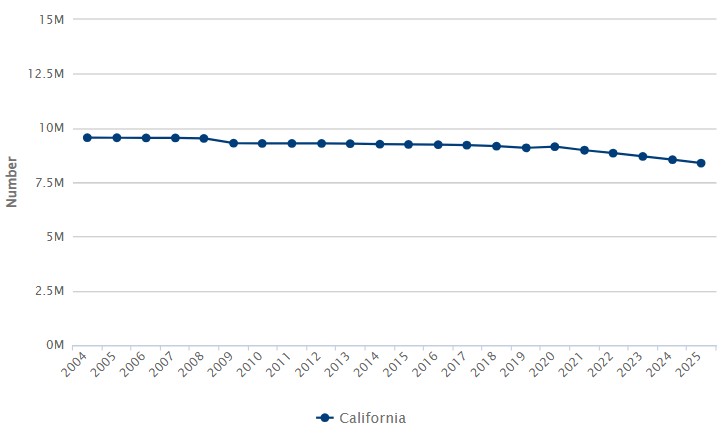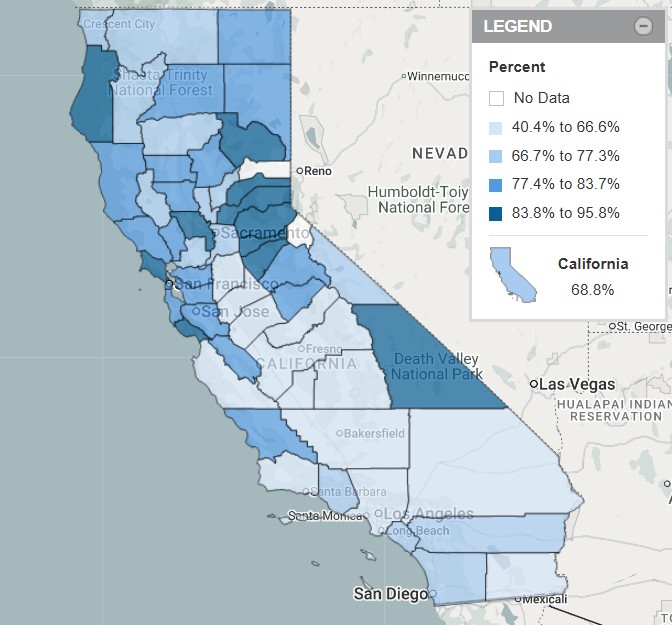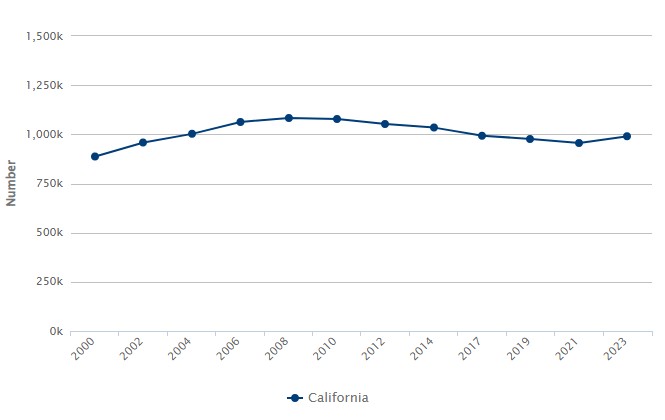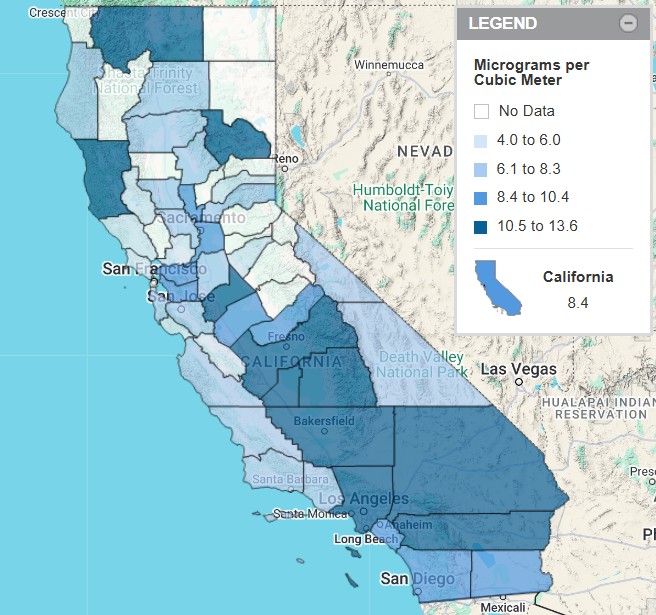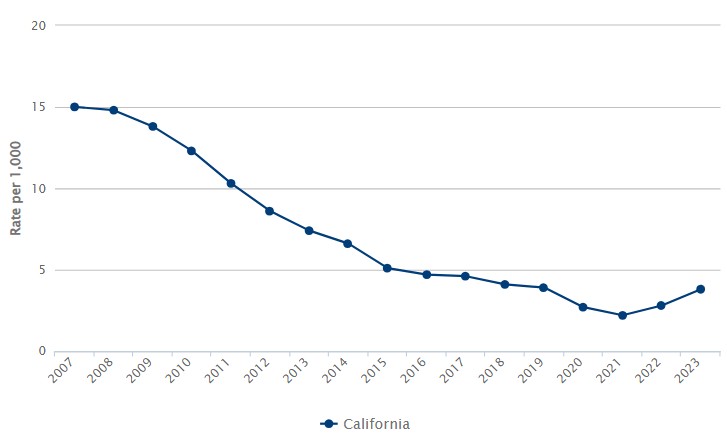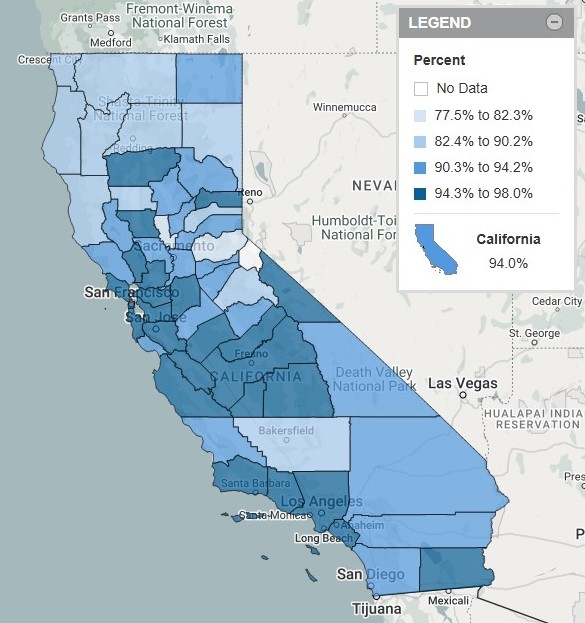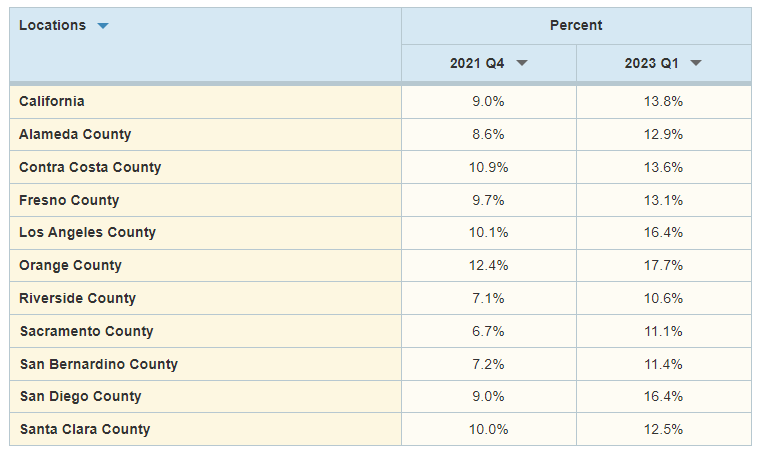Food Insecurity Impacts More Than 1 in 6 Kids
In response to the U.S. Department of Agriculture’s (USDA’s) recent decision to stop collecting data on household food insecurity, KidsData is exploring alternative sources for measuring childhood food insecurity in California.
Food insecurity—when a household lacks the money or other resources to provide consistent, dependable access to enough food for everyone in the household to enjoy active, healthy lives—is a major public health problem in California and across the nation. Compared with food-secure children, children experiencing food insecurity are at higher risk for a host of health problems with potentially lifelong impacts, including acute and chronic developmental, behavioral, mental, and physical health conditions.
Percentage of California Children Ages 0 to 17 Living in Food-Insecure Households: 2023
According to the latest estimates based on federal data sources, more than one in six California children live in a household experiencing food insecurity—up from around one in eight in 2020. This translates to over 1.4 million kids—more than the total child population of Massachusetts or Missouri—in 2023. In 26 of California’s 58 counties, at least one in every five children lived in a food-insecure household.
Food assistance programs such as the Supplemental Nutrition Assistance Program (SNAP, or CalFresh in California) provide a safety net to help low-income children and their families access adequate nutrition. Participation in these programs is shown to reduce poverty and improve overall health in childhood, and is linked to positive economic and health outcomes in adulthood.
CalFresh served nearly 5.5 million Californians, including nearly 2 million children, in July 2024. Compared with 10 years earlier, CalFresh participation in 2024 was up 22% for Californians of all ages but down 16% for Californians ages 0 to 17. See KidsData for policy options to boost nutrition program access, participation, and benefits for children and families in need.
KidsData in the News
A Merced FOCUS story about obesity rates in San Joaquin Valley counties cites KidsData’s indicators of students who are overweight or obese, which are featured in the California Health Care Foundation’s 2025 California Latino Health Dashboard.
Children’s Health Resource
The Impact of Positive Childhood Experiences (PCEs) on Behavioral Health Outcomes
A new resource from the California Essentials for Childhood Initiative looks at how PCEs shape behavioral health outcomes in adulthood and describes strategies to promote positive experiences, environments, and relationships during the early years.
Posted by kidsdata.org
Post Comment
Number of California Kids at a 30-Year Low, and Projected to Continue Dropping
Demographic trends help project needs for education, child care, health care, and other services. To plan appropriate policies and programs, policymakers need to understand the size and composition of the communities they serve, how these vary by location, and how populations are changing. In California, growing numbers of retiring seniors and a shrinking child population point to workforce and taxpayer shortages in the coming decades. These population dynamics mean children are a more important resource than ever before—creating new urgency to ensure today’s children have the supports they need to reach their full potential.
Number of California Children Ages 0 to 17: 2004 to 2025
In 2004, 9,559,942 children ages 0 to 17 lived in California; today more than 1 million fewer kids (8,386,716) call the state home. In just the last five years, California’s child population has fallen by more than 760,000 and in the next five years it’s expected to fall by another 635,000. By 2060, fewer than 6.7 million children will live in California—a drop of more than 30% from the mid-2000s peak.
Compared with 1995—the first year for which comparable data are available—the number of children is down statewide and in most counties. But trends vary widely at the local level. The 10 California counties with the smallest child populations (fewer than 5,500 in 2025) have seen some of the steepest declines—all have lost at least 15% of their child population in the last 30 years, and half have lost more than 30%. Looking forward to 2060, three of these counties—Lassen, Modoc, and Mono—are projected to have less than half as many children as today.
Yet small counties are not alone—Los Angeles (the state’s largest county by far) has lost 29% of its child population since 1995 and is projected to lose 31% more by 2060.
On the other hand, some regions—particularly the Sacramento area and San Joaquin Valley—have experienced strong child population growth over the last three decades. Fresno, Kern, Kings, Madera, Merced, Placer, Sacramento, San Joaquin, Tulare, and Yuba counties all have seen their number of children grow by at least 10% between 1995 and 2025.
Among the 12 counties with the fastest growth over this period, five have a child population with a Hispanic/Latino majority above 70%. Statewide, just under half of kids (48%) are Hispanic/Latino, around one-fourth (26%) are white, 13% are Asian, 7% are multiracial, 5% are African American/Black, and less than 1% are American Indian/Alaska Native or Native Hawaiian/Pacific Islander. At the county level, estimates of the share of Hispanic/Latino children in the total child population range from 11% to 91%, while the share of white children ranges from 4% to 66%.
Society’s reliance on a decreasing number of increasingly diverse children highlights the importance of policy and program options that nurture every child. See KidsData for strategies aimed at aligning service systems with demographic trends and ensuring that adequate, culturally responsive resources are in to place to support thriving children, families, and communities.
KidsData in the News
Crisis Point: Spike in Black Youth Suicide Rates Trigger Alarm Among Advocates
A California Black Media story examining rates of suicide among young people of color statewide and nationally cites KidsData’s indicator of youth suicides by race/ethnicity.
How the Federal Government Shutdown Is Affecting the Inland Empire [subscription required]
A story published in news outlets across Southern California on the impacts of the federal government shutdown cites KidsData on Women, Infants, and Children (WIC) program participation in Riverside and San Bernardino counties.
Children’s Health Resources
Evidence-Based Youth Mentorship Programs
A new resource from the California Essentials for Childhood Initiative looks at evidence-based programs that promote mentorship and adult engagement with youth and provides information about their effectiveness.
Measuring Childhood Disability Using the National Health Interview Survey
A new analysis of data from the National Health Interview Survey estimates the percentage of U.S. children with disabilities using four distinct identification strategies. Depending on the strategy, estimates range from 11% to 23% and show differences in disability prevalence by gender, race/ethnicity, and income level.
Opportunities
California Health Interview Survey (CHIS) Data User Training
Join the UCLA Center for Health Policy Research Thursday, October 30, at 12:00 p.m. PT to learn how to access CHIS estimates for 2024 and earlier years using the AskCHIS™ and AskCHIS™ Neighborhood Edition query tools.
Submit a Comment to Save the Current Population Survey Food Security Supplement (CPS-FSS)
Through Monday, November 3, at 8:59 p.m. PT, dataindex.us is collecting perspectives and comments on the announced termination of CPS-FSS, the only nationally representative data collection on household food insecurity. Your support for CPS-FSS will be shared with state departments of agriculture, whose leaders can urge federal decision-makers to reinstate this critical dataset.
Posted by kidsdata.org
Post Comment
In-Hospital Breastfeeding Rates Remain Lopsided Across Regions, Racial/Ethnic Groups
Breastmilk is the ideal food for infants, with few exceptions. Breastfeeding is associated with a wide range of nutritional and overall health benefits—for both children and parents—that are significant, long lasting, and overwhelmingly supported by the available evidence. Leading health organizations, including the American Academy of Pediatrics (AAP) and the World Health Organization, recommend exclusive breastfeeding for the first half year of life, followed by breastfeeding with complementary table foods through at least two years. AAP also recommends that hospitals implement care practices—such as breastfeeding within the first hour of birth—that have been shown to support successful, long-term breastfeeding.
In-Hospital Breastfeeding Initiation in California: Percentage of Newborns Breastfed Exclusively After Delivery, 2022
According to the latest data, more than 2 in 3 California infants born in 2022 were breastfed exclusively before leaving the hospital after birth. Overall, this figure is up more than 10 percentage points from 2010. Following statewide trends, rates rose in all but seven counties with data over this period.
Residents of California’s Gold Country and Sierra Nevada regions recorded some of the highest rates of in-hospital exclusive breastfeeding in 2022. Amador, Calaveras, El Dorado, Nevada, Placer, and Plumas counties each saw rates at least 15 percentage points above the state average. By contrast, rates across the San Joaquin Valley were below the statewide level.
The share of white newborns exclusively breastfed in the hospital (81% in 2020-2022) is consistently higher than for other racial/ethnic groups in California. Since 2010, only American Indian/Alaska Native newborns have been within 10 percentage points (72% in 2020-2022) of their white peers, while the gap for African American/black newborns (61% in 2020-2022) has typically been at least twice as large. Across counties with data for 2020-2022, 39 recorded exclusive breastfeeding rates above 80% for white newborns; only seven recorded such rates for Hispanic/Latino newborns.
Visit KidsData to explore policy and practice options to address disparities in breastfeeding initiation and to improve overall breastfeeding rates in the hospital, workplace, and community. Also see KidsData for data on infants who receive any breastmilk during their hospitalization, and the Maternal and Infant Health Assessment for indicators of breastfeeding intention, duration, and more.
Children’s Health Resource
The Health of California: A Regional Perspective
The UCLA Center for Health Policy Research has released a series of reports highlighting key health differences and similarities across seven distinct California regions. Using California Health Interview Survey data broken down by race/ethnicity, income level, and citizenship status, the reports examine topics such as health insurance coverage, access to care, chronic conditions, food insecurity, and housing instability in California communities.
Opportunity
California’s Changing Child Care Landscape: Understanding Costs and Supply
A new report by the Public Policy Institute of California assesses the shifting landscape of publicly supported child care for children ages 5 and younger in California, and explores whether the cost of care is affordable for families and sustainable for providers. Join the report authors Thursday, September 4, at 11:00 a.m. PT for a discussion of their findings and a Q&A session.
Recently Released Data
We recently released data about breastfeeding, health care, and intimate partner violence. See links to the latest here.
Posted by kidsdata.org
Post Comment
Spotlight on Children With Special Health Care Needs (Part 5): 10 Ways Health Conditions Impact Kids and Families
Percentage of Children With Special Health Care Needs Ages 0 to 17 Whose Conditions Affected Their Daily Activities in the Previous Year: 2023
This final installment in our series on children with special health care needs (CSHCN) describes medical, financial, educational, and personal difficulties many CSHCN and their families face. Check out our previous installments on quality of care, access to services, demographic and health characteristics, and family-centered care.
Nearly 1.5 million California children ages 0 to 17, and more than 15 million children nationwide, have special health care needs—meaning they need health and related services of a type or amount beyond that required by children generally due to chronic physical, developmental, behavioral, or emotional conditions. When this definition of children with special health care needs (CSHCN) is expanded to also include those with a diagnosed health condition and at least one functional difficulty, the numbers jump to 1.9 million statewide—22% of the child population—and nearly 19 million nationally.
For children who meet the narrower CSHCN definition, new estimates for 2023 highlight some of the impacts their ongoing health conditions can have, on themselves and on those close to them. Here are 10 indicators that paint a picture of daily life for CSHCN families—beginning with 5 that KidsData can now measure again for the first time in more than a decade:
1. More than 60% of CSHCN in California and the United States have conditions that moderately or consistently affect their ability to do the same things as other kids their age. Nationally, the share of publicly insured CSHCN whose conditions consistently affect their daily activities (22%) is twice as high as the share with private insurance (11%).
2. For California CSHCN who require therapies, medications, bandage changes, or other health care at home, more than a quarter have families who spend at least 11 hours each week providing that care.
3. More than 1 in 4 CSHCN in California visited the ER at least once in the previous year, and 1 in 10 had at least two visits. Statewide and nationally, ER visits are more common among CSHCN with public health insurance compared with those with private coverage.
4. Around 6% of California and U.S. CSHCN had an overnight hospital stay in the previous year. Among Hispanic/Latino CSHCN in California, the share was 4%; for white CSHCN, 8%.
5. Yearly out-of-pocket health care costs were higher than $1,000 for 22% of California CSHCN. Public health insurance programs kept costs manageable for many families—more than 95% of CSHCN with public insurance exclusively had out-of-pocket health costs of less than $500 in the previous year.
Updated data also point to greater challenges related to education and employment for CSHCN families:
6. The share of California CSHCN who missed 11 or more school days in the previous year due to illness or injury was 19%—around 5.5 times higher than the share of children without special health care needs.
7. The percentage of CSHCN who had ever repeated a grade in school—statewide (6%) and nationally (9%)—was more than double that for their peers.
8. An estimated 23% of CSHCN in California had parents or other family members who left a job, took a leave of absence, or cut back their work hours in the previous year because of the child’s health. Among CSHCN with more complex health care needs (those not managed primarily by prescription medications), the share was 27%.
9. For family members who continue working, health insurance often keeps them in their jobs. An estimated 18% of California CSHCN and 14% of CSHCN nationwide had someone in their family who avoided changing jobs in the previous year due to concerns about maintaining coverage.
10. Perhaps as a result of higher-than-average caregiving, economic, employment, and personal stress, parents of CSHCN are more frequently aggravated with their children than parents without CSHCN. Around 2% of children without special health care needs had parents who usually or always felt aggravation from parenting, compared with 20% of CSHCN.
Read more on KidsData about how policies and systems can promote the well-being of CSHCN and their families.
Health Data Resources
California ranks 32nd among states in overall child well-being, according to the Annie E. Casey Foundation’s latest KIDS COUNT Data Book—up from 35th in 2024. The state performed among the best in the health domain (11th) and among the worst for economic well-being (44th).
Social Determinants of Health Dashboards for Native Hawaiians and Pacific Islanders
The NHPI Data Policy Lab at the UCLA Center for Health Policy Research has launched state- and county-level data dashboards focused on the social determinants of health for Native Hawaiian and Pacific Islander communities.
Recently Released Data
We recently released data about impacts of special health care needs on children and families. See links to the latest here.
Posted by kidsdata.org
Post Comment
New Data Point to Resilience in California’s Licensed Child Care System. How Do We Sustain Progress? Guest Commentary by Natalie Rivera and Rowena Kamo
Licensed Child Care Spaces in California: 2000 to 2023

Guest authors Natalie Rivera (left), research and policy associate at the California Child Care Resource & Referral Network, and Rowena Kamo (right) explore state and local trends in licensed child care supply and cost—and what they reveal about California’s early childhood system.
The California Child Care Resource & Referral Network (R&R Network) is excited to announce the release of our 14th biennial California Child Care Portfolio, with county- and state-level data available on KidsData.org. The portfolio tracks trends in licensed child care supply, demand, and cost, and provides data on family demographics, income, and expenses.
Key Findings
Data for 2023 show California’s licensed child care supply remains steady. Compared with 2021, the state recorded modest gains of:
-
139 licensed child care facilities
- 60 child care centers
- 79 family child care homes (FCCHs)
- 27,258 licensed child care spaces (3%)
- 23,643 center spaces (3%)
- 3,615 FCCH spaces (1%)
This two-year increase in FCCH capacity is the first since 2008, and the increase in center capacity is the largest since 2006. While this growth signals progress, the number of spaces statewide remains well below levels recorded prior to and during the Great Recession, underscoring the ongoing need for sustained investment and support for providers.
Changes in supply varied by region and county. At the local level, there were substantial shifts in licensed child care capacity between 2021 and 2023. Regionally, counties in the R&R Network’s Bay Area region experienced an overall increase in licensed spaces of 7%, while the North region saw a net decrease of 2%. Variation at the county level was even more dramatic; for instance:
-
In the R&R South Region
- San Bernardino: +14%
- Imperial: -25%
- In the R&R Central Valley Region
- Mariposa: +64%
- Inyo: -39%
- In the R&R Bay Area Region
- Santa Clara: +15%
- Napa: -5%
- In the R&R North Region
- Glenn: +33%
- Modoc: -45%
Policy Priorities
Continued investments in child care systems are critical to supporting California’s working families and ensuring the stability and growth of child care programs. Program and policy options include:
Paying providers fairly. In California, the median cost of licensed FCCH care in 2022 was $1,232 per month for an infant and $969 per month for a preschooler. This means an FCCH provider caring for three infants and three preschoolers on average earned approximately $6,600 per month in gross income—more than $1,000 lower than the state’s median household income—before accounting for any business expenses.
A key step toward protecting the current supply of licensed child care is minimizing the financial strain on providers who are operating at a loss. One way the state can assist is to reform its subsidized child care reimbursement rate structure to one that reflects the true cost of care. Current reimbursement rates are based on regional market rates, or the price that a consumer is willing to pay, which may not accurately represent the actual cost of providing child care.
California also can permanently adopt a payment system based on enrollment rather than attendance. The overhead costs of running a child care business remain constant regardless of daily attendance, and providers need predictable, stable revenue to plan and sustain their operations.
Ensuring all families have access to affordable child care. Only around one in four California children with working parents had access to a licensed child care space in 2023. And availability is only part of the equation. Spending on child care represents a substantial share of the household budget for many families—in some cases on par with housing expenses. A universal child care system could ensure that affordable child care is available to every family who needs or wants it, providing crucial support for children’s development and for parents’ ability to work, pursue an education, or participate in training opportunities.
Protecting federal and state investments in child care. Funding from Head Start, TANF/CalWORKs, and the Child Care and Development Block Grant, among other sources, sustains California’s child care programs. Loss of federal funds into the state’s early childhood system means less availability of child care and more children and families in need of assistance.
Providers also rely on public assistance programs, such as SNAP/CalFresh for food assistance and Medicaid/Medi-Cal for health insurance. Cuts to these programs deepen providers’ economic insecurity, further threatening the stability and well-being of our state’s early childhood education workforce.
Visit the R&R Network’s site for more policy ideas and child care resources.
Posted by kidsdata.org
Post Comment
Air Pollution Is a Big Problem for California’s Littlest Lungs
Air pollution threatens the health of people of all ages, but children are especially vulnerable—their bodies and vital organs are still developing, they breathe more air (and with it, pollutants) relative to their size, and they generally spend more time outside or closer to the ground, where pollutant concentrations often are highest. Children also are uniquely at risk for negative developmental outcomes associated with exposure to air pollution, which can disrupt their cognition, behavior, academic performance, and economic productivity in adulthood.
Average Concentration of Fine Particulate Matter (PM2.5) in the Air, by County: 2023
Despite its strong air quality regulations and leadership on environmental policy, California is home to some of the most polluted air in the nation. In 2023, 17 counties recorded average airborne concentrations of fine particulate matter—tiny inhalable particles (2.5 microns or smaller) emitted from vehicles, wildfires, and other natural and industrial processes—above the current national primary standard of 9 micrograms per cubic meter. Concentrations above this level have been shown to be harmful to human health, especially among sensitive groups like children. In Southern California and the San Joaquin Valley, most counties averaged unhealthy PM2.5 concentrations in 2023.
These regions also reported the most days with average ozone concentrations above the public health standard of 0.070 parts per million. Kern, Los Angeles, Riverside, and San Bernardino counties each saw at least 52 days of ozone concentrations exceeding this threshold in 2023—the equivalent of at least one unhealthy air day per week.
Protecting the air we share benefits all Californians. Read more about policy and program strategies to safeguard kids and other sensitive groups, and to reduce the disproportionate burden of air pollution in lower-income areas and among communities of color.
Health Research and Resources
California Wildfires
- A new PRB research highlight, “Wildfires Devastated Their Communities. Will Californians Stay Put?,” examines the relationship between wildfire severity and migration patterns. The evidence suggests that only the most destructive fires push people to move away from affected areas.
- The California Essentials for Childhood Initiative shares ways to help children cope with stress from wildfires, and the UCLA Center for Health Policy Research reminds us that wildfires can have long-term mental health impacts.
Medicaid
- A series of fact sheets from the Center for Children and Families at Georgetown University focuses on how Medicaid promotes maternal and infant health, serves young people with disabilities or special health care needs, and provides other essential well-being support to children and families.
- Many young adults without health insurance are eligible for Medicaid. A new brief by the Urban Institute explores the characteristics of this group to inform outreach and enrollment efforts.
Adverse Childhood Experiences
- The Children’s Partnership has released a new brief with data on adverse childhood experiences (ACEs) in California and policy recommendations for investing in whole-child systems of care.
Recently Released Data
We recently released data about air quality. See links to the latest here.
Posted by kidsdata.org
Post Comment
Policymakers Can Curb Rising Child Poverty Rates
Percentage of Children Ages 0 to 17 Living in Poverty According to the
Supplemental Poverty Measure: 2023
Nearly one in five California children live without enough resources to meet their most basic needs. Statewide, according to the latest Supplemental Poverty Measure (SPM) data, there are more children in poverty than there are in the entire Bay Area (Alameda, Contra Costa, Marin, Napa, San Francisco, San Mateo, Santa Clara, Solano, and Sonoma counties combined)—or in Maryland, Massachusetts, or 35 other U.S. states.
Expansions to the social safety net during the COVID-19 pandemic brought California’s SPM child poverty rate to a historic low in 2021 (7.5%). Following the expiration of these investments, SPM rates returned to pre-pandemic levels (19%) in 2023. These trends demonstrate the powerful and rapid impact that policymakers’ actions can have on the economic well-being of millions of children and families.
Read more about evidence-based policies that could reverse rising poverty rates statewide and nationally.
More Children’s Health Resources
PRB has released two new articles highlighting recent findings in child and family health research.
From the Emergency Room to Eviction?
In a national study of families with children, a hospitalization or visit to the emergency room in the previous year was associated with a five-percentage-point increase in the probability of experiencing later housing hardship (frequent moves, difficulty paying rent or mortgage, eviction, or homelessness). Building financial security before, during, and after an unexpected hospital visit—e.g., through paid leave, housing assistance, and child allowance policies—could reduce the impacts of these health shocks on families.
Vaccination During Pregnancy May Reduce Whooping Cough in Infants
Vaccination during pregnancy is the primary strategy for whopping cough (pertussis) prevention in infants. A new analysis finds that after recommendations for all pregnant people to receive a Tdap vaccination were announced in 2012, annual rates of pertussis among infants in the U.S. fell by 54 cases per 100,000. That there was no significant change in pertussis deaths among infants could suggest that Tdap coverage among pregnant people remains too low to reduce mortality, or that mothers of the highest risk-infants are not being reached effectively.
Recently Released Resources
We recently released data about family income and poverty. See links to the latest here.
Posted by kidsdata.org
Post Comment
Juvenile Felony Arrests in California Rise by 76% in Two Years
A statement about data access and integrity:
KidsData remains committed to providing high-quality data and fact-based information to anyone who cares about advancing health and well-being in our state and across our nation.
Without evidence, we risk obscuring or distorting the realities that California’s children and families experience. KidsData exists to describe those realities in detail, so that they can guide sound decision-making.
Read a statement from PRB’s president, Jennifer Sciubba, here.
Youth who become involved with the justice system are at increased risk for negative outcomes that can have long-term consequences, such as mental health problems, dropping out of school, difficulty with employment, and rearrest. Most young people who are detained have experienced some form of trauma during childhood, and system involvement can retraumatize them, often with no benefits for crime control or public safety.
Number of Juvenile Felony Arrests per 1,000 California Young People Ages 10 to 17:
2007 to 2023
For the first time since 2007, California recorded two consecutive years of rising juvenile felony arrest rates in 2022 and 2023. Young people ages 10 to 17 were arrested for felony offenses at a rate of 3.8 arrests per 1,000 juveniles in 2023—up from a forty-plus-year low of 2.2 per 1,000 in 2021, and similar to rates before the COVID-19 pandemic (3.9 per 1,000 in 2019). This two-year upswing is the largest since the late 1980s.
There were 6,913 more juvenile felony arrests statewide in 2023 than in 2021—an increase of 76%. The number of arrests involving girls jumped by 87% over this period, while arrests of boys climbed 73%.
Violent and property offenses together accounted for nearly 70% of the state’s juvenile felony arrests in 2023, drug/alcohol and sex offenses accounted for less than 5%, and driving under the influence, hit-and-runs, weapons charges, and other crimes made up the remaining share. These percentages resemble the distributions for 2020 and 2019.
Policymakers and leaders from multiple sectors can play a role in improving how society responds to youth behavioral problems and juvenile crime. Explore policy and practice options on KidsData.
Children’s Health Resources
2025 California County Scorecard of Children’s Well-Being
Children Now has released the 2025 edition of its interactive data scorecard tracking 40 indicators of child well-being. Explore the latest county-level figures, compare data across racial/ethnic groups, and examine trends over time.
A 2024 Review of Child Care and Early Learning in the United States
The Center for American Progress’s updated report and interactive data dashboard on child care and early learning in the United States illustrate the urgent need for holistic public policymaking and robust investments that support young children, families, and early childhood educators.
Stepfathers Are Stepping Up—and Stepchildren Are Benefitting
A new PRB research highlight summarizes recent findings linking stepchildren’s feelings of closeness and participation in activities with their stepfathers to positive socio-emotional outcomes in adolescence.
Opportunity
ACT Conference: Community Strategies to Help All Children Thrive
All Children Thrive (ACT) California will host its 2025 conference on positive and adverse childhood experiences in Sacramento on April 2 and 3. Attendees can choose from five in-depth conference tracks: Community Agency and Power, Culture as a Method to Address Trauma, Equity in Action, Your Role in Healing Trauma, and Youth Power to Action (for attendees ages 14 to 25).
Recently Released Data
We recently released data about juvenile arrests. See links to the latest here.
Posted by kidsdata.org
Post Comment
Kindergarten Immunization Rates Return to Pre-Pandemic Levels, but Gaps Remain
Immunizations are among the most successful and cost-effective preventive health care interventions, protecting millions of children worldwide from serious and potentially fatal infectious diseases. Among U.S. children born between 1994 and 2023, an estimated 500 million illnesses will be prevented and more than 1.1 million lives saved by routine childhood vaccinations, at a net savings of nearly $2.7 trillion for society.
Percentage of California Kindergarteners With All Required Immunizations: 2021-22 School Year
The latest data on kindergarten immunizations in California are mixed. On one hand, 94% of the state’s more than 500,000 kindergarten students had received all doses of required vaccines—diphtheria, tetanus, and pertussis (DTP); measles, mumps, and rubella (MMR); hepatitis B; polio; and varicella—prior to entering school in 2021-22. This figure is up from 92.8% for the 2020-21 school year and is similar to pre-pandemic levels (94.3% in 2019-20). California’s rebound stands in contrast to national trends, which show falling coverage for each vaccine over this period, followed by further drops through the 2023-24 school year.
Still, more than 30,000 kindergarteners statewide had not received all required immunizations in 2022—fewer than 1 in 20 (1,511) of whom were permanently exempt from one or more immunizations due to their physical condition or medical circumstances.
Furthermore, immunization coverage at the local level is uneven. For example, more than 97% of kindergarteners in Colusa and Monterey counties were fully vaccinated in 2022, compared with fewer than 80% in El Dorado and Sutter—two counties with high proportions of kindergarteners with ‘other exemptions’ available to those receiving instruction through an individualized education program (IEP), home-based private school, or non-classroom-based independent study program.
To protect children, schools, and communities from vaccine-preventable disease outbreaks, policymakers can work to ensure that all families—in particular, those not in contact with settings where immunizations are required (such as licensed child care, preschool, and public and private K-12 schools)—have access to a regular source of high-quality health care, affordable and accessible vaccinations, and science-based vaccine information. Read more about strategies to increase immunization rates.
Wildlife Recovery Resources
Emergency help and resources are available for individuals and families impacted by the devastating wildfires in Los Angeles County. Follow the links below for federal, state, and local information and guidance.
- FEMA: California Wildfires and Straight-Line Winds
- CDC: Wildfire Smoke and Children
- State of California: Help and Info for People Affected by the Wildfires
- Medi-Cal: Emergency and Disaster Assistance Information Questions & Answers
- Los Angeles County: Emergency Information and Recovery Resources
- City of Los Angeles: Wildfire Recovery Resources
Opportunities
On January 29, at 12:00 p.m. PST, experts from the UCLA Center for Health Policy Research and Cal State Fullerton will share results from a new study on CalFresh access and use among students pursuing higher education.
Examining Measures of Disability and Health Care Need for Children and Youth
Join KidsData’s Beth Jarosz at the 2025 Applied Demography Conference in Tucson, Arizona, on February 4, at 11:15 a.m. MST, where she’ll present new analyses of three measures of disability prevalence among U.S. children and what they reveal about the sociodemographic characteristics of children identified using each measure.
Children’s Health Resources
KIDS COUNT Data Resource Guide
This guide, developed by PRB for the Annie E. Casey Foundation’s KIDS COUNT network, provides practical information and advice on how to use major U.S. sources of data on the well-being of children and families. The guide includes an overview of each major data source—what data are available, how to access those data, and considerations for use—along with some general best practices for assessing reliability, making comparisons, and disaggregating by race and ethnicity.
Kids in Common Data Book Dashboard
Explore key indicators for Santa Clara County children and families on Kids in Common’s new interactive data dashboard.
Exclusionary Discipline Threatens Youth Mental Health, but Protective Factors Can Help
A new PRB research highlight summarizes recent findings linking exclusionary discipline practices—such as detention and suspension—with anxiety and depression in students who are disciplined. Protective factors, like extracurricular activities and healthy relationships with parents, are effective buffers against mental health symptoms for all young people, regardless of whether they experience exclusionary discipline.
Recently Released Data
We recently released data about immunizations. See links to the latest here.
Posted by kidsdata.org
Post Comment
Sunsetting Pandemic Policies Highlight Safety Net’s Role in Reducing Child Poverty
Percentage of Children Ages 0 to 17 Living in Poverty, According to the California Poverty Measure: Fall 2021 to Early 2023

Patricia Malagon, guest author from the Public Policy Institute of California, explores how changes in California’s social safety net during the COVID-19 pandemic have shaped poverty trends across the state.
The California Poverty Measure (CPM), developed jointly by the Public Policy Institute of California (PPIC) and the Stanford Center on Poverty and Inequality, provides a robust measure of Californians who lack the resources to meet basic needs, accounting for local costs of living as well as safety net resources. The CPM poverty rate among Californians of all ages rose from 11.7% in fall 2021 to 13.1% in early 2023, while rates among children jumped even more dramatically. Now that pandemic-era safety net expansions have ended, this upward trend is likely to continue.
To address data limitations and to be responsive to rapidly changing policies, the CPM pivoted during the pandemic to projecting annual poverty rates from pre-pandemic data. For the early 2023 CPM, we combined the 2019 American Community Survey with data on safety net program and economic conditions in January through March 2023. (PPIC technical appendices provide details on data and methodology.)
Because most safety net programs focus on children, program expansions—and their expiration—have had a particularly large impact on child poverty. According to the CPM, child poverty in California jumped from 9% in fall 2021 to 13.8% in early 2023, yet remained below pre-pandemic levels. In early 2023, 1.2 million California children were living under the CPM poverty line—$40,765 annually, on average, for a family of two adults and two children renting their home. And about 195,000 children (2.2%) were living in deep poverty—with less than half the family resources needed to meet basic needs.
In early 2023, according to the CPM, child poverty was highest in families in which the oldest adult was unemployed (29.8%) and in single-parent families (25.6%), followed by families in which the oldest adult had not finished high school (24.1%) or was not a U.S. citizen (24.6%). Across racial/ethnic groups with data, poverty was highest among Hispanic/Latino children (18.2%).
Across counties with data, child poverty was highest in Orange County (17.7%), followed by Los Angeles and San Diego counties (both 16.4%); Riverside County had the lowest rate (10.6%). Across legislative districts, child poverty ranged from 4.7% in Assembly District 71 (San Diego County) to 29.8% in Assembly District 57 (Los Angeles County). Later in the fall, PPIC will release additional estimates for local areas, using two years of combined CPM data.
In early 2023, participation in safety net programs lifted more than 1 in 7 California children, or about 1.3 million kids, out of poverty. CalFresh alone—the only safety net program with pandemic expansions still in effect at the time—lowered child poverty by 5 percentage points; only tax credits had a greater poverty-reducing effect (5.1 percentage points) among measured programs. CalWORKs, Supplemental Security Income, housing subsidies, and other nutrition programs (school meals and WIC) lowered child poverty by less than 2 percentage points each.
If poverty rates continue rising as we expect, this could be an important policy issue next year among newly elected California legislators, many of whom may see poverty increases in their districts. PPIC will continue to monitor poverty trends and assess policies that aim to help Californians meet their basic needs.
Read more from PPIC on poverty and inequality in California.
Children’s Health Resources
Approximately 9% of federal spending went to children in 2023, and this figure is projected to fall to 6% over the next decade, according to Urban Institute’s new analysis of federal expenditures on children from 1960 to 2023.
You Count Data Hub: California Youth Homelessness Timeline
The California Homeless Youth Project has developed a comprehensive visual timeline pairing youth homelessness counts with legislative history and budget allocations from 2011 to 2023.
Launching Lifelong Health by Improving Health Care for Children, Youth, and Families
A new consensus report from the National Academies of Sciences, Engineering, and Medicine explores a transformed child and adolescent health care system—one that rethinks health care financing, public health investment, community partnerships, and accountability—to better meet all children’s needs.
Debt in America: An Interactive Map
New state and national data on medical, student loan, and auto/retail/credit card debt among young adults are available now on the Urban Institute’s Debt in America dashboard. See how young people in communities of color are faring compared with their peers in white communities, and explore policy and program options to support financial stability for young adults in the accompanying blog.
Recently Released Data
We recently released data about family income and poverty. See links to the latest here.
Posted by kidsdata.org
Post Comment



